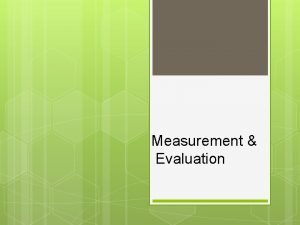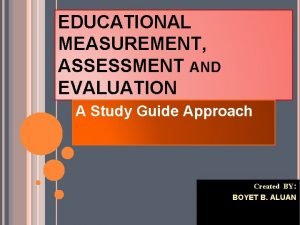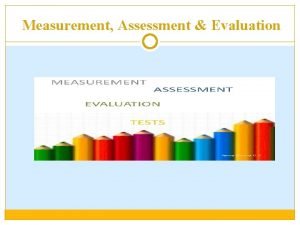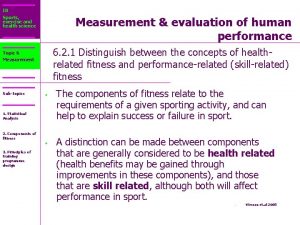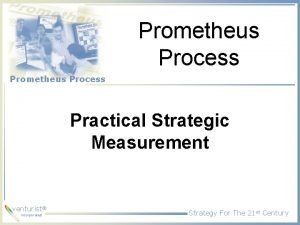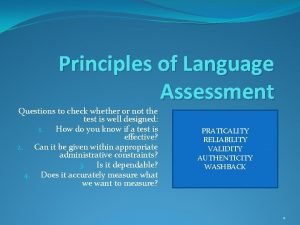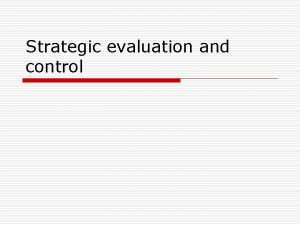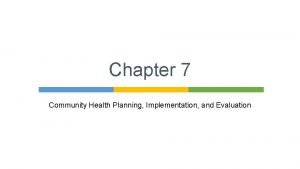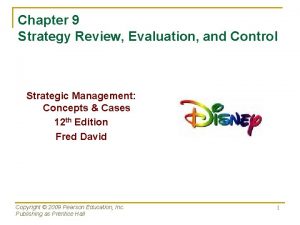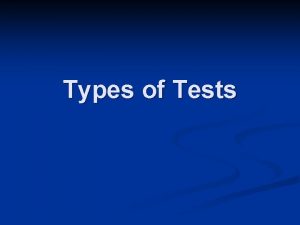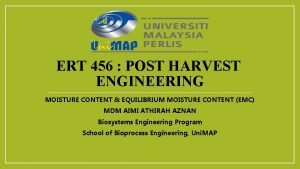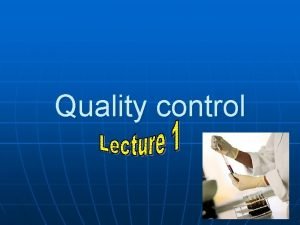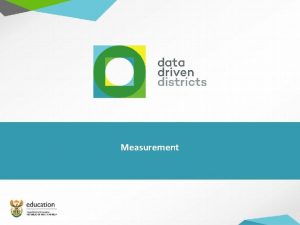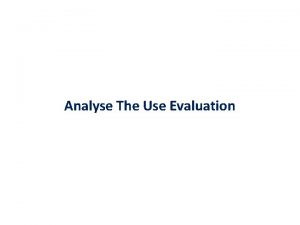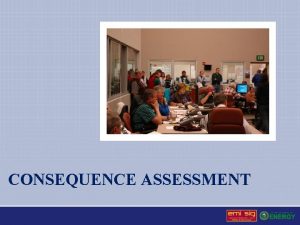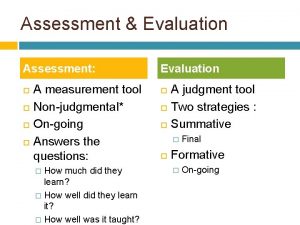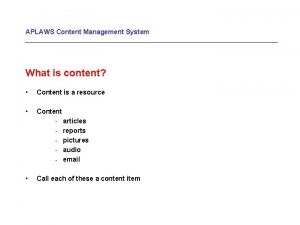Measurement Assessment Evaluation Content Definition Of Measurement Assessment
























- Slides: 24

Measurement, Assessment & Evaluation

Content Definition Of Measurement , Assessment and Evaluation Measurement Process Involves Four Steps Considerations When Taking Measurements Objective of Measurements Steps Involved In Making An Evaluation The Purposes Of Evaluation Types Of Evaluation Definition Of Norms And Its Types Reliability And Validity

Measurement According to Norman E Ground (1985): “Measurement is the process of obtaining a numarical description of the degree to which an individual possesses a particular characteristic. ” According to Ebel & Frisbie (1991): “Measurement is the process of assigning numbers to individuals or their characteristics according to specified rules. ”

Assessment According to Murry Print (1993): “Assessment involves the interpretation of measurement data. It makes sense of the data collected on student performance. ” According to Dictionary of Education (1989): “Assessment is the process whereby one attempts to measure the quality and quantity of learning and teaching using various assessment techniques. ”

Evaluation § “A systematic process of determining what the actual outcomes are but it also involves judgment of desirability of whatever outcomes are demonstrated. ” (Travers, 1955) § “ The process of delineating, obtaining and providing useful information for judging decision alternatives” (Stufflebeam et al 1971)

How can we measure anything?

Is it Test? ECG MACHINE

? What is Test “Test is an instrument or activity and systematic procedure for measuring a sample of behavior. ” (How well does the individual perform).

Measurement Process Involves Four Steps 1. DEFINE THE CHARACTERISTICS THAT YOU WANT TO MEASURE. 2. SELECT THE APPROPRIATE TEST. THIS MAY ALSO MEAN TO SELECT THE APPROPRIATE TESTING INSTRUMENT. 3. ADMINISTER THE TEST. IF AN INSTRUMENT IS INVOLVED IN THE TESTING, THIS ALSO MEANS TO USE THE INSTRUMENT CORRECTLY. 4. COLLECT AND RECORD THE MEASUREMENT FROM THE TEST.

Considerations When Taking Measurements 1. REMEMBER THAT YOU ARE MEASURING A CHARACTERISTIC OF THE PERSON—YOU ARE NOT MEASURING THE PERSON THEMSELVES; THUS, MAKE NO JUDGMENTS ABOUT THE PERSON. 2. MAKE NO COMICAL REMARKS REGARDING THE COLLECTED DATA. 3. HAVE A HIGH ETHICAL STANDARDS WHEN COLLECTING THE DATA. 4. BE PROFESSIONAL

Types of Measurements Objective measurements An objective measurement is one that cannot be interpreted differently because of numerical values Subjective measurements A subjective measurement is one that can possibly be interpreted differently.

The Purposes of Evaluation According to Oguniyi (1984) To determine the relative effectiveness of the programme in terms of students’ behavioural output; To make reliable decisions about educational planning; To identify studaents’ growth or lack of growth in acquiring desirable knowledge, skills, attitudes and societal values; To help teachers determine the effectiveness of their teaching techniques and learning materials; To help motivate students To identify problems To predict the general trend in the development of the teaching-learning process;

Types Of Evalaution FORMATIVE EVALUATION SUMMATIVE EVALUATION

Steps Involved in Making an Evaluation Define the objective or the purpose of the test. Measure the performance or administer the test. Find or develop a standard. Compare a person’s performance on the test to a standard. Make the evaluation then discuss and distribute the results in the most appropriate manner.

Advantages of Formative Evaluation Formative evaluation enables the teacher to: Draw more reliable inference about his students than an external assessor, although he may not be as objective as the latter; Identify the levels of cognitive process of his students; Choose the most suitable teaching techniques and materials; Determine the feasibility of a programme within the classroom setting; Determine areas needing modifications or improvement in the teaching-learning process; and Determine to a great extent the outcome of summative evaluation. (ogunniyi, 1984)

Advantages of Summative Evaluation 1. ITS EXISTENCE (LEARNERS WILL NEED TO BE AWARE OF IT FROM THE START) PROVIDES MOTIVATION AND HELPS CREATE AN APPROPRIATE LEARNING ENVIRONMENT. 2. POSITIVE RESULTS GIVE THE TRAINEES A BOOST IN CONFIDENCE AND CAN ACT AS A SPRINGBOARD INTO SUBSEQUENT BEHAVIOUR CHANGE BACK IN THE WORKPLACE. 3. TRAINERS CAN IDENTIFY THOSE AREAS WHERE RESULTS ARE CONSISTENTLY LOWER AND CAN THEN CONSIDER ALTERNATIVE DELIVERY METHODS – HELPING TO DEVELOP THE TRAINING FOR FUTURE EVENTS.

Formative vs Summative FORMATIVE <-----------------> SUMMATIVE INFORMAL <------------------> FORMAL CONTINUOUS <-------------------> FINAL PROCESS <-------------------> PRODUCT

Norms refers to information regarding the group performance of a particular reference on a particular measure for which a person can be compared to. Norms mean standardized score. Scores on psychological test are most commonly interpreted by reference to norm that represents the test performance on standardization sample. Norms always represent the best performance.

Purpose of Norms BASICALLY THERE ARE TWO PURPOSES OF NORMS: 1. NORMS INDICATE THE INDIVIDUAL’S RELATIVE STANDING IN THE NORMATIVE SAMPLE AND THUS PERMIT EVALUATION OF HIS/HER PERFORMANCE IN REFER TO OTHER PERSONS. 2. NORMS PROVIDE COMPARED MEASURES THAT PERMITTED A DIRECT COMPARISON OF THE INDIVIDUAL

Types of Norms 1. LOCAL NORM: NORMS BASED ON A • RELATIVELY SMALL GROUP OF SUBJECTS. EX: PULL-UP NORMS FOR 7 TH GRADE BOYS AT ONE SCHOOL. 2. STATE NORMS: NORMS THAT ARE REPRESENTATIVE OF ALL SIMILAR SUBJECTS IN THE STATE. EX: FITNESS NORMS FOR 7 TH GRADE BOYS. 3. NATIONAL NORMS: NORMS THAT ARE REPRESENTATIVE OF ALL SIMILAR SUBJECTS IN THE UNITED STATES. EX: FITNESS NORMS FOR 7 TH GRADE GIRLS.

Reliability and Validity RELIABILITY IS THE DEGREE TO WHICH AN ASSESSMENT TOOL PRODUCES STABLE AND CONSISTENT RESULTS. VALIDITY REFERS TO HOW WELL A TEST MEASURES WHAT IT IS PURPORTED TO MEASURE.

Types of Reliability

Types of Validity

 Concept map of measurement assessment and evaluation
Concept map of measurement assessment and evaluation Prognostic test
Prognostic test Definition of measurement in education
Definition of measurement in education What is esp
What is esp Dynamic content vs static content
Dynamic content vs static content Grain moisture content measurement
Grain moisture content measurement Progress and performance measurement and evaluation
Progress and performance measurement and evaluation Measurement and evaluation in human performance 5e download
Measurement and evaluation in human performance 5e download Vertical jump adalah
Vertical jump adalah Strategic measurement and evaluation
Strategic measurement and evaluation Evaluation in progress
Evaluation in progress Measurement and evaluation for health educators
Measurement and evaluation for health educators Types of validity
Types of validity Principle of language assessment
Principle of language assessment Richard rumelt criteria for strategy audit
Richard rumelt criteria for strategy audit Community health planning and implementation certificate
Community health planning and implementation certificate Chapter 11 assessment and evaluation of sports injuries
Chapter 11 assessment and evaluation of sports injuries Continuity assessment record and evaluation
Continuity assessment record and evaluation Consonance in strategic management
Consonance in strategic management Evaluation n
Evaluation n Difference between assessment and evaluation
Difference between assessment and evaluation Fatality assessment and control evaluation
Fatality assessment and control evaluation Equilibrium moisture content definition
Equilibrium moisture content definition Ecm wiesbaden
Ecm wiesbaden Content uniformity definition
Content uniformity definition
